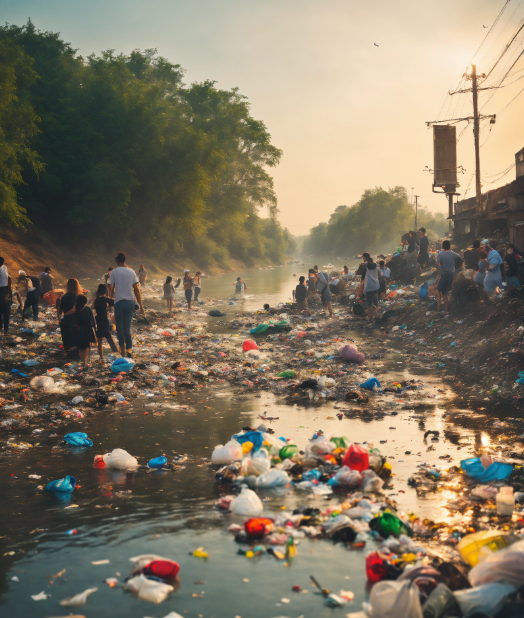Table of Contents
TogglePollution in India
Introduction
Pollution in India has reached alarming levels, impacting the health of millions and the environment. With rapid industrialization and urbanization, the issue of pollution has become a pressing concern that needs immediate attention. Addressing pollution is not just about protecting the environment but also ensuring the well-being of current and future generations.
Types of Pollution
- Air Pollution
- Water Pollution
- Soil Pollution
- Noise Pollution
Air Pollution

Air pollution from industry, vehicles, agriculture, and natural events harms health and the environment. Key pollutants like sulfur dioxide, nitrogen oxides, and particulate matter cause diseases and climate change. Solutions include stricter regulations, renewable energy, electric vehicles, and international cooperation. Addressing air pollution is essential for health and sustainability
Sources of Air Pollution
The primary contributors to air pollution are vehicles, factories, and agricultural activities. The use of outdated technology and lack of stringent regulations exacerbate the problem
Impact on Health and Environment
Air pollution can cause respiratory diseases, cardiovascular problems, and even premature death. It also affects the environment by damaging crops, forests, and bodies of water.
Water Pollution

Water pollution from industrial discharges, agricultural runoff, sewage, and plastic waste harms ecosystems and human health. Contaminants like chemicals and pathogens damage aquatic life and disrupt food chains, leading to diseases and affecting drinking water and recreation. Solutions include stricter regulations, better waste management, and sustainable farming. Public awareness and community action are crucial for reducing pollution. Protecting water quality is vital for biodiversity, public health, and future water access
Major Pollutants
Common pollutants include heavy metals, pesticides, and untreated sewage. These contaminants make the water unsafe for drinking and harmful to aquatic life.
Consequences for Aquatic Life and Human Health
Polluted water can lead to diseases such as cholera and dysentery. It also affects aquatic ecosystems, leading to a decline in biodiversity and the disruption of food chains.
Soil Pollution

Soil pollution from industry, agriculture, waste disposal, and mining threatens ecosystems and human health. Contaminants like heavy metals and pesticides degrade soil, harm plants and animals, and enter the food chain. This reduces crop yields, biodiversity, and can cause health issues. Solutions include stricter regulations, sustainable farming, and site remediation. Public awareness and eco-friendly waste management are crucial for preventing soil pollution and protecting the environment and food security.
Causes and Effects
The use of pesticides and fertilizers in agriculture, industrial activities, and deforestation are significant causes. Contaminated soil affects crop quality and can lead to food safety issues.
Impact on Agriculture
Polluted soil reduces agricultural productivity and can lead to the accumulation of toxins in crops, posing health risks to consumers.
Noise Pollution

Noise pollution, caused by traffic, industrial activities, construction, and urbanization, negatively impacts human health and wildlife. Constant exposure to loud noises can lead to hearing loss, stress, sleep disturbances, and cardiovascular issues in humans. For wildlife, noise pollution disrupts communication, mating rituals, and habitats. Solutions include implementing stricter noise regulations, promoting the use of quieter technologies, and urban planning that incorporates noise barriers and green spaces. Public awareness and community efforts are crucial for reducing noise pollution and creating healthier, quieter environments for all living beings.
Common Sources
Vehicles, construction sites, and industrial machinery are the main contributors to noise pollution.
Effects on Mental and Physical Health
Chronic exposure to noise pollution can lead to hearing loss, stress, and cardiovascular problems. It also affects mental health, causing anxiety and sleep disturbances.
Major Cities Affected by Pollution
Delhi
Delhi, the capital city, is infamous for its poor air quality. The Air Quality Index (AQI) often reaches hazardous levels, primarily due to vehicular emissions, industrial activities, and seasonal crop burning in neighboring states.
Mumbai
Mumbai faces significant pollution challenges from industrial emissions and vehicular traffic. The city’s coastal location also means that marine pollution is a major concern.
Kolkata
Kolkata struggles with both air and water pollution. The Hooghly River, running through the city, is heavily polluted, and the air quality is often compromised by industrial and vehicular emissions.
Chennai
Chennai deals with pollution from industrial waste and noise pollution. The rapid industrial growth in and around the city has led to significant environmental degradation.
Health Impacts of Pollution
Pollution has a direct impact on health, contributing to a range of diseases and health conditions.
Respiratory Diseases
Exposure to polluted air can cause asthma, bronchitis, and other chronic respiratory conditions. Children and the elderly are particularly vulnerable.
Cardiovascular Problems
Air pollution is linked to heart diseases and strokes. Fine particulate matter (PM2.5) can enter the bloodstream, causing inflammation and increasing the risk of cardiovascular events.
Long-term Health Consequences
Long-term exposure to pollution can lead to chronic health issues, including cancer, neurological disorders, and reproductive problems.
Environmental Impacts
Effect on Wildlife
Pollution affects wildlife by contaminating their habitats, leading to a decline in species populations and biodiversity.
Impact on Ecosystems
Ecosystems are disrupted by pollution, which can alter the natural balance and lead to the loss of flora and fauna.
Climate Change and Global Warming
Pollution contributes to climate change by increasing the concentration of greenhouse gases in the atmosphere, leading to global warming and extreme weather events.
FAQs
What are the main sources of pollution in India?
The main sources include vehicular emissions, industrial discharges, agricultural activities, and improper waste disposal.
How does pollution affect human health?
Pollution can cause respiratory and cardiovascular diseases, chronic health issues, and even premature death.
What steps can individuals take to reduce pollution?
Individuals can reduce pollution by using public transport, conserving energy, recycling, and supporting eco-friendly initiatives.
What is the role of the government in controlling pollution?
The government enforces regulations, implements pollution control programs, and promotes awareness and education about pollution.
How can technology help in combating pollution?
Technological solutions like air and water purifiers, renewable energy sources, and sustainable practices can significantly reduce pollution levels.
